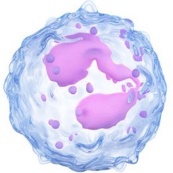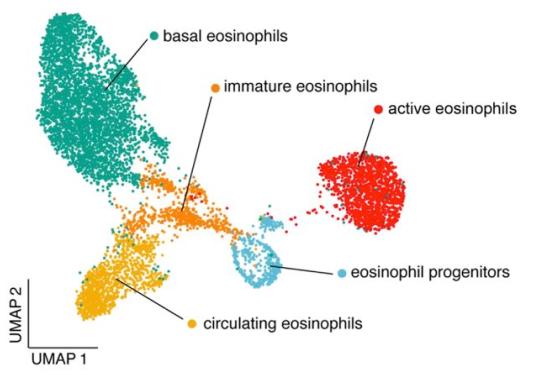Immunomics Services
Immunomics Services for Eosinophils
Eosinophils are granulocytes that develop in the bone marrow from pluripotent progenitor cells. They contribute significantly to the pathogenesis of various diseases, including asthma and respiratory allergies, eosinophilic gastrointestinal disorders, eosinophilic syndromes, and parasitic infections. CD Genomics offers immunomics services for eosinophils to help clients gain a more detailed understanding of the mechanisms of immune responses in which they are involved.

Introduction to Eosinophils
Eosinophils are granulocytes that develop in the bone marrow from pluripotent progenitor cells. They are released into the peripheral blood in a phenotypically mature state, where they can be activated and recruited into tissues under appropriate stimuli, most notably the cytokines interleukin-5 (IL-5) and eotaxin chemokines. Eosinophils remain in the peripheral blood only for a short time, with a half-life of 18 hours. Then, they migrate to the thymus or gastrointestinal tract where they reside in equilibrium conditions.
Functions of Eosinophils
Through their large cytokine pool and participating cellular contacts, eosinophils modulate immune responses through a series of interacting and coordinating mechanisms, in trans and cis, through cellular and humoral mediators in the innate and adaptive immune response.

Modulating Lymphocyte Recruitment
Eosinophils are recruited to the GI tract and lung tissue, and it emphasizes the influence of lymphocytes on eosinophil recruitment. Notably, many experiments have shown that eosinophils can interact with lymphocytes in a bidirectional manner, instead of passively responding to chemotactic signals.

Behaving as Antigen-presenting Cells
Eosinophils have the ability to present antigens to T cells. Upon exposure to allergens, eosinophils express mechanisms of antigen presentation and a full set of costimulatory molecules at the protein level. Moreover, eosinophils migrate to the draining lymph nodes promoting the proliferation of antigen-specific T cells in vitro.

Driving Th2 Polarization
Eosinophils are capable of driving Th2 responses in a variety of ways. An important Th2 feature of eosinophils is their ability to produce typical Th2 cytokines, such as IL-4, IL-5, and IL-13, to drive Th2 polarization alone when stimulated. In addition, eosinophils engage in direct crosstalk with DCs to activate Th2 together with DCs.
Immunomics Study of Eosinophils
To study functional subpopulations of eosinophils performing specialized tasks in health and disease to determine their functional contribution to intestinal health and disease, cellular-level transcriptomics and high-dimensional flow cytometry were used to study and analyze eosinophils from multiple mouse tissues. Five distinct subpopulations were identified, representing successive stages of development and maturation of each organ, each controlled by a specific set of transcription factors.
- Progenitor cells in the BM, are the only proliferative stage.
- Immature eosinophils, characterized by granule protein production, are present in the BM and blood.
- Circulating eosinophils migrate to target tissues.
- Basal eosinophils are a tissue-resident population endowed with morphogenetic properties.
- Digestive tract-activated eosinophils are characterized by PD-L1 and CD80 expression, bactericidal activity, and tissue-protective functions during inflammation.
 Fig.1 UMAP of eosinophil transcriptomes. (Gurtner, A., et
al., 2021)
Fig.1 UMAP of eosinophil transcriptomes. (Gurtner, A., et
al., 2021)
Our Services
Eosinophils are major contributors to homeostasis, immune regulation, and host defense of the organism. CD Genomics offers a wide variety of immunomics research services to help clients delve into the ontogenetic processes, classification of cell types, and functions of cell subpopulations of eosinophils.
Why Choose Us
Eosinophils exhibit considerable phenotypic, morphological, and functional diversity within tissues. CD Genomics has focused on immunomics research for many years and is able to help clients develop refined and targeted solutions to study eosinophils.
